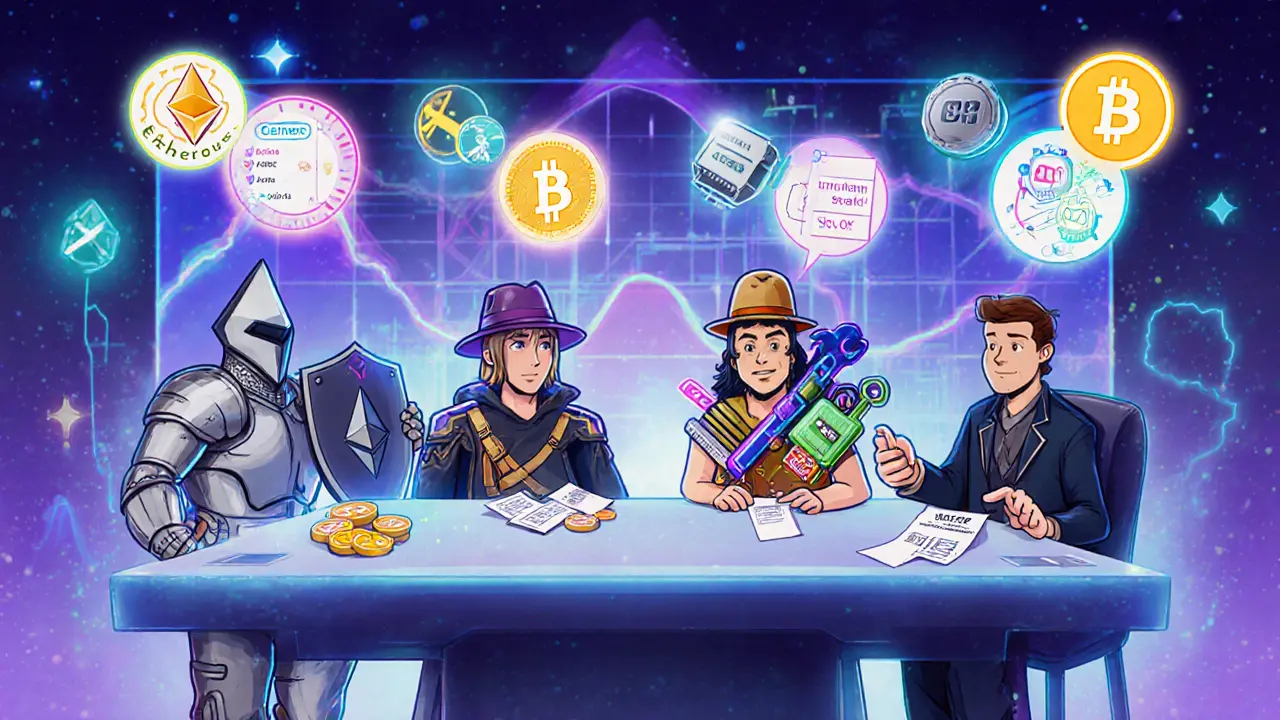Validator Network Comparison Tool
This tool compares key attributes of major validator networks to help you understand their differences and suitability for your needs.
| Attribute | Ethereum (PoS) | Cosmos (Tendermint) | Solana (PoH+PoS) | DPoS (e.g., EOS) |
|---|---|---|---|---|
| Minimum Stake | 32 ETH (~$60k) | 10,000 ATOM (~$20) per validator | ~1 SOL (hardware-intensive) | 0 - delegation only |
| Typical APR | 4-7% | 7-10% | 6-9% | 5-12% (varies by producer) |
| Hardware Needs | Modest (CPU, 200 GB SSD) | Standard server specs | High-end CPU + NVMe + 300 Mbps uplink | None for delegators |
| Decentralization Rating | High (500k+ validators) | Medium (few thousand zones) | Low-Medium (few thousand validators) | Low (few hundred block producers) |
| Governance Model | On-chain voting + EIP upgrades | Inter-chain governance via Cosmos SDK | On-chain committee & token votes | Token-holder voting for producers |
Based on the comparison, we can identify some key patterns:
- Ethereum offers the highest decentralization but requires the highest initial investment.
- Cosmos provides interoperability with moderate stake requirements.
- Solana delivers high throughput but demands significant hardware resources.
- DPoS systems allow for easy delegation but may suffer from centralization risks.
Consider your capital availability, technical expertise, and risk tolerance when choosing a network.
Select your preferences to get personalized recommendations on staking options:
Recommended Staking Options:
Quick Summary
- Validator networks are the backbone of modern Proof‑of‑Stake blockchains, securing transactions with staked assets instead of energy‑hungry mining.
- Ethereum, Cosmos, and Solana illustrate three distinct approaches: pure PoS, interoperable multi‑chain, and high‑throughput validation.
- Key risks include centralization of stake, technical complexity, and slashing penalties for downtime.
- Emerging tools-liquid staking, staking‑as‑a‑service, and advanced BFT algorithms-aim to broaden participation and improve safety.
- Looking ahead, validator networks will become more energy‑efficient, interoperable, and accessible to non‑technical investors.
What Validator Networks are distributed groups of blockchain nodes that lock up assets as stake and run consensus software to propose, verify, and attest to new blocks?
In a Proof‑of‑Stake world, a validator locks a certain amount of the native token as collateral. That stake gives the node the right to participate in block production. When a validator behaves honestly, it earns rewards in the form of newly minted tokens and transaction fees. Misbehaviour-like double‑signing or prolonged downtime-triggers Slashing a penalty that destroys part of the validator’s locked stake to deter attacks.
The network’s security comes from the economic value at risk rather than raw computational power. This shift from energy‑intensive mining to stake‑based security is why many industry observers see validator networks as the future of sustainable blockchain infrastructure.
Core Functions of a Validator
Every validator performs three essential jobs:
- Attestation: signing a cryptographic vote that a proposed block follows protocol rules.
- Block Proposal: occasionally being selected to create a new block and broadcast it to peers.
- Finality Assurance: helping the network reach Byzantine Fault Tolerance a property that allows the system to tolerate a fraction of faulty or malicious nodes while still achieving consensus.
Combined, these steps keep the ledger accurate, prevent double‑spending, and ensure that once a block is finalized it cannot be reverted without massive economic loss.
Current Landscape: Major Ecosystems
Today, three blockchain families showcase how validator networks can be tailored to different goals.
Ethereum the world’s largest smart‑contract platform that transitioned to Proof‑of‑Stake in September 2022 (the "Merge") runs a massive network of over 500,000 validators, each staking 32 ETH. The minimum stake creates a high barrier to entry, but the sheer scale provides strong decentralization. Annual returns typically sit between 4‑7% after accounting for performance fees and occasional penalties.
Cosmos an ecosystem of interoperable blockchains that uses the Tendermint BFT consensus algorithm allows validators to secure multiple zones (individual chains) simultaneously. This multi‑chain approach encourages specialization and provides a gateway for cross‑chain token transfers via IBC.
Solana a high‑throughput blockchain that combines Proof‑of‑History with a fast Proof‑of‑Stake validator set demands robust hardware (high‑speed SSDs, powerful CPUs) because it processes up to 65,000 transactions per second. Validator rewards are attractive, but the technical requirements limit participation to well‑funded operators.
These three examples illustrate a spectrum-from Ethereum’s broad accessibility (though with a high capital floor) to Solana’s performance‑focused but hardware‑intensive model, and Cosmos’s interoperable flexibility.

Beyond Pure PoS: Delegated and Hybrid Models
Some networks replace direct staking with a delegation layer. In Delegated Proof‑of‑Stake a system where token holders vote for a limited set of trusted validators, everyday users can delegate their stake without running a node. This design speeds up block finality but concentrates power among a few elected validators, raising centralization concerns.
Hybrid models, such as those exploring Liquid Staking protocols that issue derivative tokens representing staked assets, aim to combine flexibility with security. Users can keep their capital fluid for DeFi activities while still earning validator rewards.
Key Challenges Facing Validator Networks
Centralization of Stake - Large whales can command enough tokens to dominate validator sets, potentially steering governance decisions.
Technical Complexity - Running a validator demands 99.9% uptime, secure key management, and regular software upgrades. Mistakes lead to Slashing, which can eat into profits or wipe out the stake entirely.
Network‑Level Risks - Bugs in consensus code, unexpected forks, or attacks on the underlying P2P layer can jeopardize the whole validator set.
Addressing these issues is essential for the long‑term health of any blockchain that relies on validator security.
Future Directions: What’s on the Horizon?
Several trends are converging to shape the next generation of validator networks:
- Energy‑Efficient Consensus: New BFT variants (e.g., HotStuff, GRANDPA) aim to reduce communication overhead while preserving safety.
- Improved Slashing Protection: Multi‑sig wallets and telemetry‑based safety nets are being built to detect misbehavior before penalties hit.
- Broader Access via Staking‑as‑a‑Service: Companies like Figment and Staked simplify node operation, letting smaller investors participate without meeting high hardware or capital thresholds.
- Cross‑Chain Validator Sets: Projects are experimenting with shared validator pools that secure multiple chains at once, boosting efficiency and security through economies of scale.
- Regulatory Clarity: As governments draft staking‑specific regulations, compliance tools will emerge, making institutional participation easier.
These developments suggest validator networks will become more inclusive, resilient, and environmentally friendly, reinforcing their role as the cornerstone of decentralized finance.
How to Get Involved Today
If you’re curious about staking but don’t want to manage a full node, consider these pathways:
- Direct Staking: Meet the minimum stake (e.g., 32 ETH) and run your own validator using cloud providers or dedicated servers.
- Staking‑as‑a‑Service: Pay a small fee to a validator operator who handles uptime, upgrades, and slashing protection on your behalf.
- Liquid Staking Platforms: Deposit your tokens into protocols like Lido to receive a tradeable receipt token (stETH) that accrues staking rewards.
- Delegated Staking: In DPoS chains, simply vote for trusted validators and let them do the heavy lifting.
Each option balances control, reward rate, and risk. Evaluate your technical comfort, capital, and risk tolerance before committing.
Validator Network Comparison
| Attribute | Ethereum (PoS) | Cosmos (Tendermint) | Solana (PoH+PoS) | DPoS (e.g., EOS) |
|---|---|---|---|---|
| Minimum Stake | 32 ETH (~$60k) | 10,000 ATOM (~$20) per validator | ~1 SOL (hardware‑intensive) | 0 - delegation only |
| Typical APR | 4‑7% | 7‑10% | 6‑9% | 5‑12% (varies by producer) |
| Hardware Needs | Modest (CPU, 200GB SSD) | Standard server specs | High‑end CPU + NVMe + 300Mbps uplink | None for delegators |
| Decentralization Rating | High (500k+ validators) | Medium (few thousand zones) | Low‑Medium (few thousand validators) | Low (few hundred block producers) |
| Governance Model | On‑chain voting + EIP upgrades | Inter‑chain governance via Cosmos SDK | On‑chain committee & token votes | Token‑holder voting for producers |

Frequently Asked Questions
What exactly does a validator do?
A validator locks up a stake, proposes new blocks when selected, checks transactions for validity, signs attestation votes, and helps the network reach finality. In return, they earn block rewards and transaction fees.
How risky is staking?
Risk comes from three sources: market volatility of the staked token, technical failures that trigger slashing, and potential centralization that could affect network governance. Using reputable staking services and diversifying across multiple validators can mitigate many of these risks.
Can I stake without owning the minimum amount?
Yes. Liquid staking platforms let you deposit any amount and receive a tokenized receipt that accrues rewards. You can trade or use that receipt in DeFi while still earning staking yields.
Will validator networks become more centralized over time?
There’s a tension. Large stakeholders can accumulate influence, but newer protocols are adding caps, randomized selection, and incentive tweaks to keep power spread. The trend leans toward balancing efficiency with decentralization.
What’s the environmental impact compared to Bitcoin mining?
Proof‑of‑Stake validator networks consume a fraction of the electricity used by Proof‑of‑Work miners-often less than 0.01% of Bitcoin’s annual consumption-making them a far greener choice for securing blockchain data.


jit salcedo
When you stare into the abyss of validator economics, the abyss stares back, whispering about decentralization and profit motives. The layers of stake, hardware, and governance form a kaleidoscope that can both enlighten and confuse the casual observer.
Choose wisely, lest your capital evaporate like a mirage in a desert of code.